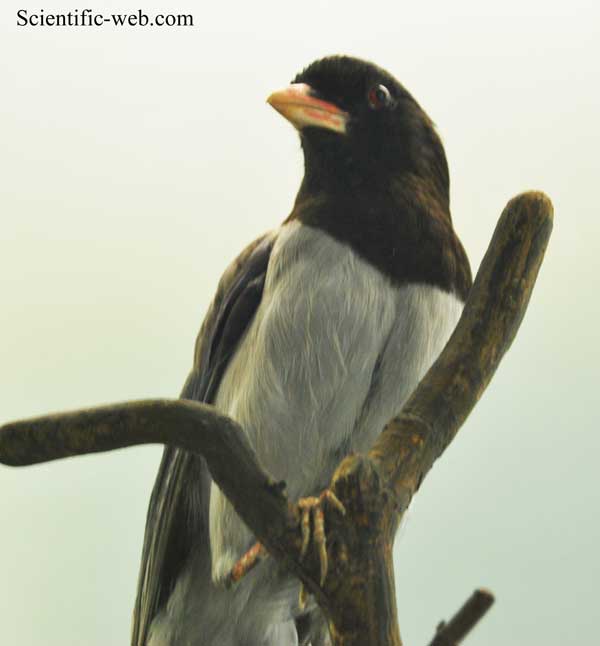
Urocissa erythrorhyncha, Photo: Michael Lahanas
Superregnum: Eukaryota
Regnum: Animalia
Subregnum: Eumetazoa
Cladus: Bilateria
Cladus: Nephrozoa
Superphylum: Deuterostomia
Phylum: Chordata
Cladus: Craniata
Subphylum: Vertebrata
Infraphylum: Gnathostomata
Superclassis: Tetrapoda
Cladus: Reptiliomorpha
Cladus: Amniota
Classis: Reptilia
Cladus: Eureptilia
Cladus: Romeriida
Subclassis: Diapsida
Cladus: Sauria
Infraclassis: Archosauromorpha
Cladus: Crurotarsi
Divisio: Archosauria
Subsectio: Ornithodira
Subtaxon: Dinosauromorpha
Cladus: Dinosauria
Ordo: Saurischia
Cladus: Eusaurischia
Cladus: Theropoda
Cladus: Neotheropoda
Infraclassis: Aves
Ordo: Passeriformes
Subordo: Passeri
Parvordo: Corvida
Superfamilia: Corvoidea
Familia: Corvidae
Genus: Urocissa
Species: Urocissa erythroryncha
Subspecies: U. e. alticola – U. e. brevivexilla – U. e. erythroryncha – U. e. magnirostris – U. e. occipitalis
Name
Urocissa erythroryncha (Boddaert, 1783)
Synonyms
Corvus erythrorynchus (protonym)
Urocissa erythrorhyncha (orth. err.)
Cissa erythroryncha
References
Table des Planches Enluminéez d'Histoire Naturelle de M. D'Aubenton: 38 #622.
Vernacular names
বাংলা: লালঠোঁট নীলতাউরা
català: Garsa blava de bec vermell
English: Red-billed Blue Magpie
Esperanto: Ruĝbeka pigo
español: Urraca piquirroja
فارسی: زاغی آبی نوکسرخ
suomi: Loistoharakka
français: Pirolle à bec rouge
日本語: サンジャク
latviešu: Sarkanknābja zilā žagata
Nederlands: Roodsnavelkitta
polski: Kitta czerwonodzioba
پنجابی: کھپر
svenska: Rödnäbbad blåskata
Tiếng Việt: Giẻ cùi
中文(繁體): 紅嘴藍鵲
中文: 红嘴蓝鹊
The red-billed blue magpie (Urocissa erythroryncha) is a species of bird in the crow family, Corvidae. It is about the same size as the Eurasian magpie, but has a much longer tail, one of the longest of any corvid. It is 65–68 cm (25.5–27 in) long and weighs 196–232 g (6.9–8.2 oz).[2]
Taxonomy
The red-billed blue magpie was described by French polymath Georges-Louis Leclerc, Comte de Buffon in 1775 in his Histoire Naturelle des Oiseaux.[3] The bird was also illustrated in a hand-coloured plate engraved by François-Nicolas Martinet in the Planches Enluminées D'Histoire Naturelle which was produced under the supervision of Edme-Louis Daubenton to accompany Buffon's text.[4] Neither the plate caption nor Buffon's description included a scientific name, but in 1783, Dutch naturalist Pieter Boddaert coined the binomial name Corvus erythrorynchus in his catalogue of the Planches Enluminées.[5] The specimen described by Buffon had come from China, but the type location was restricted to Canton by Hugh Birckhead in 1937.[6] The red-billed blue magpie is now one of five species placed in the genus Urocissa that was introduced by German ornithologist Jean Cabanis in 1850.[7][8] The name of the genus combines the Ancient Greek oura meaning "tail" and kissa meaning "magpie". The specific epithet erythroryncha combines the Ancient Greek eruthros meaning "red" and rhunkhos meaning "bill".[9]
Five subspecies are recognised:[8]
U. e. occipitalis (Blyth, 1846) – northwest India to east Nepal
U. e. magnirostris (Blyth, 1846) – northeast India to south Indochina
U. e. alticola Birckhead, 1938 – north Myanmar and south-central China
U. e. brevivexilla R. Swinhoe, 1874 – northeast China
U. e. erythroryncha (Boddaert, 1783) – central, east, and southeast China, north Indochina
Description
The head, neck, and breast are black with a bluish spotting on the crown. The shoulders and rump are a duller blue, and the underparts are a greyish cream. The long tail is a brighter blue (as are the wing primaries) with a broad, white tip. The bill is a bright orange-red, as are the legs and feet and a ring around each eye. This red can vary across its range to almost yellow in some birds.
Red-billed blue magpie
Feeding in Uttarakhand, India
In Uttarakhand, India
Habits and habitat
The red-billed blue magpie occurs in a broad swath from the northern parts of the Indian subcontinent, and further eastwards. It ranges from the western Himalayas eastwards into Myanmar, Thailand, Cambodia, Laos, and Vietnam, and through central and eastern China to southwest Manchuria, in evergreen forest and scrub in predominantly hilly or mountainous country. It has adapted to urban habitat, and can be seen in large cities in China such as Beijing and Hong Kong. They nest in trees and large shrubs in a relatively shallow nest. Usually, three to five eggs are laid.
Red-billed blue magpie in Shimla Water Catchment Wildlife Sanctuary H.P.
Food is sought both in trees and on the ground. It takes the usual wide range of food, such as invertebrates, other small animals, and fruit and some seeds. It robs nests of eggs and also chicks. Vocal mimicry is very apparent in this species, and its calls are very varied, but the most usual are a grating rattle and a high-pitched whistle somewhat like a flute.
References
BirdLife International (2018). "Urocissa erythroryncha". IUCN Red List of Threatened Species. 2018: e.T22705802A130380978. doi:10.2305/IUCN.UK.2018-2.RLTS.T22705802A130380978.en. Retrieved 11 November 2021.
"Pirolle à bec rouge - (Urocissa erythrorhyncha) Red-billed Blue Magpie" (in French). Oiseaux.net. Retrieved 28 March 2011.
Buffon, Georges-Louis Leclerc de (1775). "Le geai de la Chine à bec rouge". Histoire Naturelle des Oiseaux (in French). Volume 5. Paris: De L'Imprimerie Royale. p. 157-158.
Buffon, Georges-Louis Leclerc de; Martinet, François-Nicolas; Daubenton, Edme-Louis; Daubenton, Louis-Jean-Marie (1765–1783). "Le geai, de Chine". Planches Enluminées D'Histoire Naturelle. Volume 7. Paris: De L'Imprimerie Royale. Plate 622.
Boddaert, Pieter (1783). Table des planches enluminéez d'histoire naturelle de M. D'Aubenton : avec les denominations de M.M. de Buffon, Brisson, Edwards, Linnaeus et Latham, precedé d'une notice des principaux ouvrages zoologiques enluminés (in French). Utrecht. p. 38, Number 622.
Birckhead, Hugh (1937). The birds of the Sage West China Expedition. American Museum Novitates, No. 966. New York: American Museum of Natural History. p. 13. hdl:2246/3867.
Cabanis, Jean (1850–1851). Museum Heineanum : Verzeichniss der ornithologischen Sammlung des Oberamtmann Ferdinand Heine, auf Gut St. Burchard vor Halberstadt (in German and Latin). Volume 1. Halberstadt: R. Frantz. p. 87.
Gill, Frank; Donsker, David, eds. (2019). "Crows, mudnesters, birds-of-paradise". World Bird List Version 9.2. International Ornithologists' Union. Retrieved 25 August 2019.
Jobling, James A. (2010). The Helm Dictionary of Scientific Bird Names. London: Christopher Helm. pp. 150, 397. ISBN 978-1-4081-2501-4.
Retrieved from "http://en.wikipedia.org/"
All text is available under the terms of the GNU Free Documentation License

